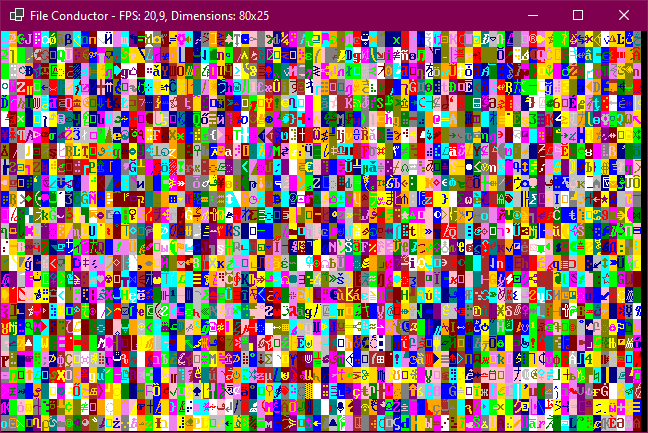(Drawing Text Isn't Simple: Benchmarking Console vs. Graphical Rendering)
Drawing Text on Screen - What Could Be Simpler?
So, this all started because I decided to learn Go. Polyglots say the best way to learn one is by doing something fun with it. Some watch movies, some read, some play with flashcards, others just jump into deep water and start talking with zero vocabulary.
I figured that logic should work for programming languages too - so I picked a fun target project: writing a text-based file manager. Think old-school Norton Commander or Dos Navigator. My personal favorite is still FAR Manager - it's insanely productive, still actively developed, and honestly the main reason I haven't switched to Linux or macOS yet.
Anyway, FAR Manager's code is in a language I don't speak, and writing plugins wouldn't get me where I want, so... I decided to just rewrite the whole thing. Easy, right? I know it's ridiculous, but that's fine - I like big impossible projects. Aim for the Moon, etc.
The Plan
I won't spoil the full idea (still might build it), but I disclose these two main modules:
- Input handling (keyboard, mouse)
- Output handling (drawing text on screen)
Let's skip the boring input stuff - it works, after wrestling with all the quirks of Windows' console mode. Long story short: the “modern” VT (Virtual Terminal) mode that Windows adopted from Linux is slower output and dumber input than the old API. It doesn't even tell you when Shift is pressed, only when you actually type an uppercase letter with it. Add in a few more edge cases like Ctrl+Alt+Shift chaos, and you get the idea. I found workarounds, though, so keyboard input is mostly done.
Now, the fun part.
Output: Drawing Text
How hard can it be to draw letters on a screen, right?
There are several ways to do it in the Windows console:
- Old way:
WriteConsoleOutputW- directly dump characters and color data to the screen. - New way:
WriteConsoleW- embed color codes in the text (the VT way), richer (e.g. bold, italic, underline)
The new one is half as fast. On a modern mid-range PC, that's just sad.
So I looked for better options - maybe GPU acceleration? Some people pointed me to GPU-powered terminals with buttery-smooth rendering. Sounded good, so I dug deeper.
After days of poking Go, forums, and LLMs, it became clear that Go is not made for things like this. So I switched to something battle-tested: C#. (And if anyone tells you "every language can do anything", please slap them with a large trout. I mean, sure - but at what cost?)
C# means .NET, which can power full-blown 3D games, so drawing text should be child's play! I tried three rendering paths:
- GDI - the classic Windows graphics interface. Works even "without" a GPU, so obviously not fast.
- DirectX - the big guns, made for real-time 3D games.
- Vulkan - similar to DirectX but cross-platform.
I built a simple benchmark using all three plus the two console methods. The screen was 240x63 characters (Full HD with a 8x16 font). Test conditions were intentionally rough - every character with random colors - just to stress the system.

Results (random colors everywhere)
| Renderer | 240x63 | 80x25 |
|---|---|---|
| WriteConsoleOutputW | 20.3 | 64.5 |
| WriteConsoleW | 12.9 | 64.5 |
| GDI | 22.2 | 64.5 |
| Vulkan | 23.5 | 175.2 |
| DirectX | 17.6 | 130.5 |
All of them sucked, basically. Even with optimizations. But I measured the "optimistic" ways as well.
Results (realistic: white on black)
| Renderer | 240x63 | 80x25 |
|---|---|---|
| WriteConsoleOutputW | 64.5 | 64.5 |
| WriteConsoleW | 64.5 | 64.5 |
| GDI | 62.4 | 64.5 |
| Vulkan | 114.4 | 733.0 |
| DirectX | 140.2 | 944.5 |
Now we're talking. GPU rendering finally pays off - DirectX crushed it.
A Different Angle
Turns out the real bottleneck isn't the rendering API - it's Windows' font drawing (which is sadly CPU-bound). So I tried something unconventional: draw each character once, cache it as a texture, and then just copy those textures around. Copying pixels is much faster than redrawing fonts every frame.
That alone gave a massive speed bump in stress test (random colors):
| Resolution | DirectX + Texture |
|---|---|
| 240x63 | 66.4 |
| 80x25 | 450.1 |
Nice jump - but there's a catch.
The Catch
Texturing looks great on paper, but you lose flexibility. You can't really optimize texture copies much more. On the other hand, writing text directly can be heavily optimized - for example, drawing an entire line at once when color and style match. That gives 5-7x speedups in practice.
| Resolution | DX + text | DX + texture | Change |
|---|---|---|---|
| 240x63 | 17.6 | 66.4 | +377% (stress test) |
| 80x25 | 130.5 | 450.1 | +345% (stress test) |
| 240x63 | 140.2 | 66.4 | -47% (normal use) |
| 80x25 | 944.5 | 450.1 | -47% (normal use) |
So - caching helps in extreme cases, but slows things down in normal ones.
Conclusion
The sweet spot is DirectX + direct text drawing. It's fast enough, flexible, and still keeps the door open for fancier options like Vulkan if I ever go cross-platform.
Moral of the story: Drawing text on screen isn't simple, most of the internet forums got the bottleneck wrong, only a selected few know what's really happening under the hood.